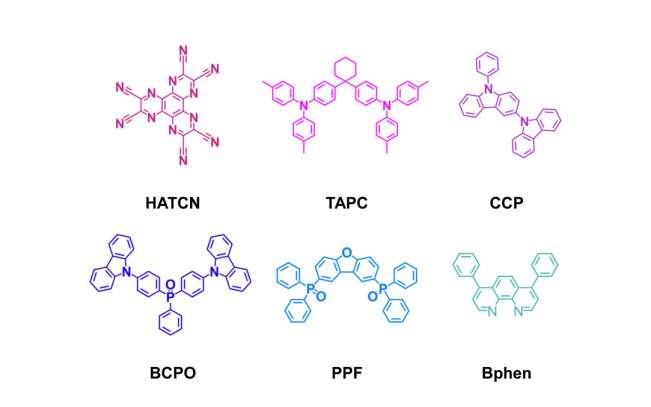This article has been reviewed according to Science X's editorial process and policies. Editors have highlighted the following attributes while ensuring the content's credibility:
fact-checked
peer-reviewed publication
trusted source
proofread
Researchers develop high-performance blue organic LEDs based on thermally activated delayed fluorescence material

Organic light-emitting diodes (OLEDs) have become a leading display technology. The luminescent material is a core component of OLEDs. Thermally activated delayed fluorescence (TADF) materials have emerged as promising emitters for achieving high-efficiency OLEDs.
Blue TADF-OLEDs confront more pronounced efficiency roll-off and material degradation issues compared to their green and red counterparts, owing to the formation of high-energy excitons through bimolecular reactions of long-lived excited states.
To pave the way for future TADF-OLED applications, it is crucial to develop advanced blue TADF molecules with extremely short exciton lifetimes, ideally in the nanosecond scale. Simultaneously achieving a high photoluminescence quantum yield (PLQY), ultrashort exciton lifetime, and suppressed concentration quenching in TADF materials is desirable yet challenging.
In a study published in Advanced Materials, a research group led by Prof. Lu Canzhong from Fujian Institute of Research on the Structure of Matter of the Chinese Academy of Sciences reported a new strategy for designing high-performance blue TADF materials, and developed a blue TADF material with high emission efficiency, nanosecond emission lifetime, and effectively suppressed concentration quenching, enabling the realization of high-performance nondoped and doped blue OLEDs.
The researchers designed and synthesized a acceptor-donor-acceptor (A-D-A) type TADF molecule, namely 2BO-sQA, bearing a dispirofluorene-quinolinoacridine (sQA) donor and two cofacial oxygen-bridged triarylboron (BO) acceptors which are nearly orthogonal to the sQA donor.
This unique molecular structure facilitates achieving an extremely narrow singlet-triplet energy gap, thereby accelerating reverse intersystem crossing and achieving ultra-short emission lifetimes. Such a short delayed fluorescence lifetime is uncommon in high-efficiency TADF materials and is expected to be beneficial in mitigating exciton annihilation in the emitting layer and suppressing efficiency roll-off at high luminance levels.
The molecular rigidity and intramolecular interactions also effectively inhibit non-radiative transitions, ensuring high emission efficiency. Rigid three dimensional A-D-A molecular architecture can effectively suppress aggregation caused emission quenching at high doping concentrations. The films containing 2BO-sQA, with concentrations ranging from 10 wt% to 100 wt%, exhibit high PLQYs of 99% to 86%.
The OLEDs utilizing 2BO-sQA as the terminal luminescent emitter demonstrated excellent electroluminescent characteristics with no significant dependence on concentration, maintaining maximum external quantum efficiencies (EQEmax) at over 30% for doping concentrations ranging from 10 to 70 wt%. Remarkably, the nondoped blue OLED achieved a record-high maximum EQE of 26.6% with a small efficiency roll-off of 14.0% at a luminance of 1,000 cd m-2.
Hyperfluorescence OLEDs employing 2BO-sQA as the sensitizer and v-DABNA as the terminal dopant realized narrowband deep-blue emission with high EQEs of up to 32.3%. The EQE roll-off at 1,000 cd m-2 decreased significantly from 40.1% for the control device to 14.5% for the hyperfluorescence OLED with 40 wt% 2BO-sQA, likely attributed to the short exciton lifetime of the sensitizer.
These results demonstrated the potential of 2BO-sQA as a sensitizer for achieving high-performance deep blue hyperfluorescence OLEDs.
This study sheds new light on the development of ideal blue TADF materials that simultaneously exhibit high emission efficiency, ultrashort exciton lifetime, and suppressed concentration quenching, which are highly desirable for achieving high-performance blue OLEDs.
More information: Shao‐Jie Wu et al, Thermally Activated Delayed Fluorescence with Nanosecond Emission Lifetimes and Minor Concentration Quenching: Achieving High‐Performance Nondoped and Doped Blue OLEDs, Advanced Materials (2024). DOI: 10.1002/adma.202401724
Journal information: Advanced Materials
Provided by Chinese Academy of Sciences





















